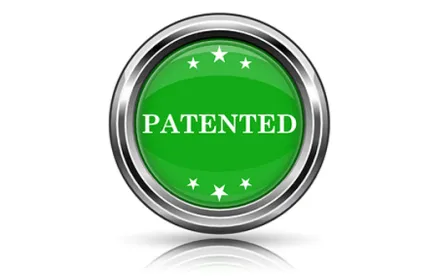A design patent protects the visual ornamental characteristics of an article, including consumer and industrial products, medical devices and related tools, sports equipment, jewelry, product packaging, and even web-based and mobile graphical user interfaces and icons. Yet, design patent protection for these types of products is often overlooked in favor of other forms of IP protection.
Companies tend to rely on utility patents, which cover the function of a device, to prevent others from making, using, selling, or importing infringing products. While utility patents can be a broader and stronger form of protection in terms of protecting the way an article of manufacture is used or functions, they typically do not protect the visual appearance of the product. Design patents protect a product’s appearance or other “ornamental” features, not its function. This allows for protecting designs that have a unique visual appearance, regardless of whether or not the product is functionally unique. As a result, design patents can be especially useful for larger companies looking to strengthen an already existing IP portfolio and for smaller companies building their IP portfolio from the ground up.
Design patents may offer a number of important benefits in developing an IP portfolio:
Expanding Coverage of Products
Companies spend significant resources developing a product’s design and its packaging to enhance the user’s end-to-end experience. This generally involves fine-tuning the overall visual appearance, such as the shape, color, texture, or pattern, of the product or packaging that gives the product a unique look. This unique look may be captured and protected by strategically filing design patents to target various features of the product and its packaging.
Design patents include a single claim and drawings that constitute the entire visual disclosure of the claim. The drawings can be strategically prepared to cover the entire product, or modified to protect only specific features of the product, such as one or more illustrated components, shapes, colors, textures, patterns, and sequences. Thus, a well-planned design patent strategy can supplement a company’s IP portfolio by limiting other parties’ ability to copy unique but non-functional design aspects of a product.
Design patents may also be used to protect features of designs in some instances when utility patents may not available. For example, a company may develop a new design for a pen. While the new pen may not function in a way that is sufficiently different from existing pens to obtain a utility patent, a design patent can be used to protect the ornamental appearance of the new pen design.
Improved Ability to Prevent Unauthorized Sales, Knock-offs, and Counterfeits
Design patents can bolster IP portfolios and improve a company’s ability to prevent or stop unauthorized sales, knock-offs, and counterfeits. With the increasing prevalence of various e-commerce platforms, it is becoming increasingly easier to sell products online. Though the expansion of e-commerce has made buying and selling goods more convenient, it has also expanded the ability for third party sellers to make unauthorized sales of products, and produce and sell counterfeits. This can be extremely harmful to a company’s bottom-line, brand, and customer satisfaction, especially in the case of counterfeits that may be of substandard quality.
As described below, design patents may be issued relatively quickly, providing a faster boost in available assets for enforcement against these unauthorized sellers. Design patents may also lead to significant infringement damages—in 2018, Apple Inc. was awarded over $500 million when a jury found that Samsung Electronics Co., Ltd. infringed its design patents.
In the case of counterfeits and unauthorized sales, design patents may be used to more quickly and easily prove infringement, as the drawings issued in the design patent provide a visual illustration that can be held next to and be compared directly with the accused product. This can be especially useful in identifying infringing products online or at U.S. Customs and Border Protection (CBP), and preventing imports of infringing products into the U.S. through enforcement proceedings at the International Trade Commission (ITC). Further highlighting the importance of design patents, the Counterfeit Goods Seizure Act of 2019, if enacted, will give CBP the discretionary authority to rely on design patents when seizing infringing products even without an exclusion order first being issued by the ITC.
Reduced Time and Cost
Design patents also offer numerous time and cost advantages relative to other forms of intellectual property.
Reduced Time from Filing to Grant: Generally, design patents issue within 1 to 2 years (or sooner) of filing compared to 3 to 5 years for utility patents. This allows for design patents to be more quickly available for enforcement against a potential third party selling a copycat, knock-off, or counterfeit product. The reduced prosecution timeline also provides companies with the ability to build and strengthen their IP portfolio at a faster rate, which can be valuable when seeking external investment.
Reduced Cost: Design patents may present the opportunity to obtain patent protection at a reduced cost. For example, the fees associated with filing, prosecuting, and issuing design patents are generally less expensive than utility patents. As an added bonus, there are no maintenance fees after a U.S. design patent issues for the duration of the 15-year patent term.
Because of the reduced cost, design patents provide a cost-effective tool to expand IP portfolios by also protecting accessories or devices that have limited commercial value, but are still worth protecting for offensive and defensive purposes.
Ability to Control Publication of Designs
Patent law in the U.S. and many other countries operates under a first-to-file system. In other-words, when two inventors separately file for similar inventions, the one who files first generally has the right over the other to pursue their invention. This makes it beneficial to file patent applications as soon as possible. But, filing a patent application starts the clock on how soon the application and its contents become publicly available, which can be detrimental to companies still developing the technology disclosed in the patent application filing.
Design patents offer the ability (at least in the U.S.) to both control publication timing and obtain an early filing date. For example, in the U.S. design patents only become public upon issuance of the patent. Internationally, the publication timeline is country-dependent. When protecting designs through the Hague System, publication typically occurs six months after the filing date, but may occur sooner or later depending on the country, and depending on the option selected at the time of filing. As another example, China does not offer any statutory procedure for deferring publication of a design patent. Publication of design patents can be effectively controlled through well-considered prosecution and filing strategies.
Accordingly, design patent protection should be considered in as part of any IP portfolio.





 />i
/>i
